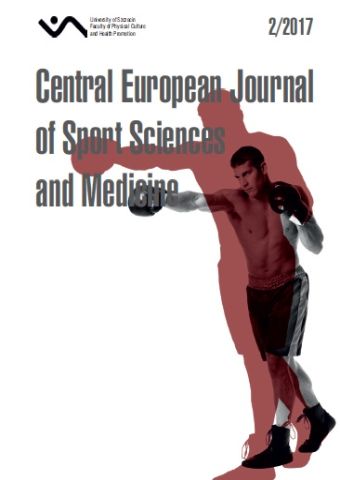
ISSN: 2300-9705
eISSN: 2353-2807
OAI
DOI: 10.18276/cej.2017.2-01




Issue archive /
Vol. 18, No. 2/2017
The Importance of Directly Derived Information in the Basketball Jump Shot. A Comparison of Changed Visual Conditions from Different Shooting Spots
| Authors: |
Alexander
Pohl
University of Hildesheim, Institute of Sport Science, Germany Markus Böker University of Hildesheim, Institute of Sport Science, Germany Linda Hennig University of Hildesheim, Institute of Sport Science, Germany Thomas Heinen University of Hildesheim, Institute of Sport Science, Germany |
| Keywords: | basketball especial skills generalized motor program jump shot visual perception |
| Data publikacji całości: | 2017 |
| Page range: | 8 (5-12) |
Abstract
The basketball jump shot as a movement, allowing visual feedback based corrections, can be considered as a generalized or a specialized motor skill. The purpose of this study is to look into the connection between visual perception and the specialization of a motor skill. Therefore, six male basketball players were asked to perform jump shots under different viewing conditions from their favourite spot (sweet spot) and a second, middle-distance spot. The question was, if performance is affected by the changed visual conditions and whether the shooting spot plays a role in a potentially change in performance. The different visual conditions were first, a regular basketball hoop with no adjustment, second a regular basketball hoop with a covered backboard, and third a regular basketball hoop with a covered rim. Between the different visual conditions, performance did not differ significantly, neither from the sweet spot, nor from the neutral defined spot. However, players showed a significantly better performance from sweet spot than from the neutral spot under regular viewing conditions.
Download file
Article file
Bibliography
| 1. | Clauss, S., Schmidt, G.J. (1996). Korbwurf. In: G. Hagedorn, D. Niedlich, G.J. Schmidt (eds.), Das Basketball Handbuch (pp. 151–160). Reinbek: Rowohlt. |
| 2. | de Oliveira, R.F., Oudejans, R.R., Beek, P.J. (2006). Late information pick-up is preferred in basketball jump shooting. Journal of Sports Sciences, 24 (9), 933–940. |
| 3. | de Oliveira, R.F., Huys, R., Oudejans, R.R.D., van de Langenberg, R., Beek, P.J. (2007). Basketball jump shooting is controlled online by vision. Experimental Psychology, 54 (3), 180–186. |
| 4. | de Oliveira, R.F., Raôul, R.D., Oudejans, R.R., Beek, P.J. (2008). Gaze behavior in basketball shooting: Further evidence for online visual control. Research Quarterly for Exercise and Sport, 79 (3), 399–404. |
| 5. | de Oliveira, R.F., Oudejans, R.R., Beek, P.J. (2009). Experts appear to use angle of elevation information in basketball shooting. Journal of Experimental Psychology: Human Perception and Performance, 35 (3), 750. |
| 6. | Keele, S.W., Posner, M.I. (1968). Processing of visual feedback in rapid movements. Journal of Experimental Psychology, 77 (1), 155–158. |
| 7. | Keetch, K.M., Lee, T.D., Schmidt, R.A. (2008). Especial skills: Specificity embedded within generality. Journal of Sport & Exercise Psychology, 30 (6), 723–736. |
| 8. | Keetch, K.M., Schmidt, R.A., Lee, T.D., Young, D.E. (2005). Especial skills: their emergence with massive amounts of practice. Journal of Experimental Psychology: Human Perception and Performance, 31 (5), 970–978. |
| 9. | Oudejans, R.R., van de Langenberg, R.W., Hutter, R.V. (2002). Aiming at a far target under different viewing conditions: Visual control in basketball jump shooting. Human Movement Science, 21 (4), 457–480. |
| 10. | Ripoll, H., Bard, C., Paillard, J. (1986). Stabilization of head and eyes on target as a factor in successful basketball shooting. Human Movement Science, 5 (1), 47–58. |
| 11. | Schmidt, R.A. (2003). Motor schema theory after 27 years: reflections and implications for a new theory. Research Quarterly for Exercise and Sport, 74 (4), 366–375. |
| 12. | Schmidt, R.A., Zelaznik, H., Hawkins, B., Frank, J.S., Quinn Jr, J.T. (1979). Motor-output variability: a theory for the accuracy of rapid motor acts. Psychological Review, 86 (5), 415–451. |
| 13. | Shea, C.H., Wulf, G. (2005). Schema theory: A critical appraisal and reevaluation. Journal of Motor Behavior, 37 (2), 85–102. |
| 14. | Vickers, J.N. (1996). Visual control when aiming at a far target. Journal of Experimental Psychology: Human Perception and Performance, 22 (2), 342–354. |
| 15. | Vickers, J.N. (2007). Perception, cognition, and decision training: The quiet eye in action. Champaign: Human Kinetics |
| 16. | Wright, D.L., Shea, C.H. (1991). Contextual dependencies in motor skills. Memory & Cognition, 19 (4), 361–370. |